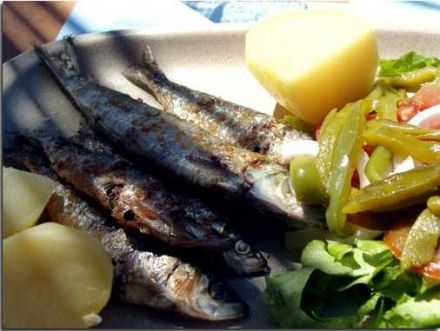 |
A culinary journey through Algarve
Divine tastes from the land and sea: the cuisine of Algarve is a culinary art developed over many years of history and with long traditions, unique in the world of Portuguese gastronomy. A tasty treasure that can be divided into three distinct regions:
Along the Algarve coast
Main dishes are most commonly based on fish, particularly sardines, tuna and shellfish – clams and cockles – since the proximity of the sea provides both diversity and quality. This is a region of fishermen, who every morning bring ashore fresh fish and seafood, as well as a region of excellent cooks, highly skilled in the art of preparing tasty dishes from these ingredients. The recipe for amêijoas na Cataplana provides one of the most traditional and best-loved dishes in the Algarve. Its secret lies in the method: clams cooked in a special copper pan of Arab origin.
Silver sardines, sea bream or red mullet, grilled slowly over hot charcoal, carapaus alimados (boiled and skinned mackerel shad), soups made of fish, skate or shrimp, rice cooked and served with conger, razor clams or octopus, squid cooked in its ink, cuttlefish fried in its ink, bean stew with whelks, fish stew and a garlic and bread stew with seafood: these are just some more examples of the appetizing dishes available all along the Algarve coast.
The plains of the “Barrocal” region
The intermediate strip of land marking the transition between the coast to the south and the hills to the north, known as the “Barrocal” region, has a more varied menu for, in addition to fish, common ingredients include locally grown vegetables and beef from the cattle raised in local pastures. This is a typically rural cuisine, guaranteed to whet your appetite with its broad beans cooked Algarve-style or cherry-coloured chicken, leg of lamb cooked in a casserole, chick pea stew or Algarvian cabbage stew, pickled carrots or snails cooked with aromatic herbs.
The Hills
Because of its geographical limitations, the Algarve’s stretch of hills and mountains, a barrier running from west to east between the Alentejo and the Barrocal region, has also adapted its cuisine to the local produce, without losing any of the flavours found in the south. Among the most widely appreciated delicacies are pork dishes, homemade sausages, a kind of polenta made from cornmeal and the water in which morcelas (blood sausages) were prepared, and the dark-colored smoked ham. The hunting season also adds delicious hare soup and stewed partridge to the menu.
Because of its great variety, Algarve cuisine has its own special aroma, the result of the many different condiments and spices that grow naturally in the region and which offer local cooks the chance to create subtle differences in taste. This is the case, in particular, with the healthful Mediterranean olive oil and locally grown oregano, penny-royal, rosemary and coriander. In short, the cuisine of the Algarve is a simple and practical art, but one producing rich flavorful dishes that no gourmand can resist!

If you happen to be in Algarve in August, don't miss the sardine festival that takes place in the town of Portimao from August 3-12 on the docks of the "zona Ribeirinha". The "papa sardinha" contest attracts every sardine eater.
Portimao… every travel brochure extols Praia da Rocha and Prainha beach where each evening the sand and rocks glow in the pink light of the setting sun.
Here, grilled sardines are eaten everywhere. You're in for a real surprise: their texture and flavor are incomparable. But to sample them at their best, avoid the tourist traps and head instead for the simple little restaurants where the Portuguese gather. They are very demanding when it comes to the freshness of these little ocean treats. If you're looking for something unusual, go to Coromoto's. Everyone knows him: the first ice cream maker to produce "grilled sardine" flavored ice cream. And if your curiosity is still piqued, you can also try the shrimp, cod and potato....
In Setubal, Portugal's biggest fishing port, sardines are also omnipresent. The smallest ones are dried in the sun for common consumption. Since here everything is carried on the head, the sardines cross the town in a huge tin hat , unless they're being piled up to be transported to the processing plant to be canned. It's a colorful spectacle.
Saude from Algave

-

 Recipes
Recipes
-

 Products
Products
-

 Entertaining
Entertaining
-

 Chefs
Chefs
-

 Hints & Tips
Hints & Tips
-

 Glossaries
Glossaries








